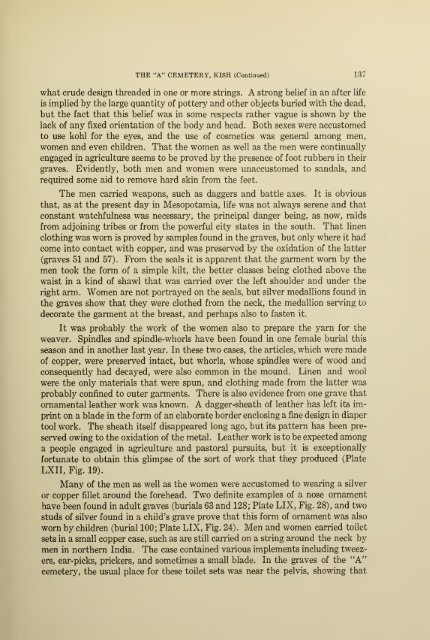A Sumerian Palace and the "A" cemetery at Kish, Mesopotamia
A Sumerian Palace and the "A" cemetery at Kish, Mesopotamia
A Sumerian Palace and the "A" cemetery at Kish, Mesopotamia
Create successful ePaper yourself
Turn your PDF publications into a flip-book with our unique Google optimized e-Paper software.
THE "A" CEMETERY, KISH (Continued) 137<br />
wh<strong>at</strong> crude design threaded in one or more strings. A strong belief in an after life<br />
is implied by <strong>the</strong> large quantity of pottery <strong>and</strong> o<strong>the</strong>r objects buried with <strong>the</strong> dead,<br />
but <strong>the</strong> fact th<strong>at</strong> this belief was in some respects ra<strong>the</strong>r vague is shown by <strong>the</strong><br />
lack of any fixed orient<strong>at</strong>ion of <strong>the</strong> body <strong>and</strong> head. Both sexes were accustomed<br />
to use kohl for <strong>the</strong> eyes, <strong>and</strong> <strong>the</strong> use of cosmetics was general among men,<br />
women <strong>and</strong> even children. Th<strong>at</strong> <strong>the</strong> women as well as <strong>the</strong> men were continually<br />
engaged in agriculture seems to be proved by <strong>the</strong> presence of foot rubbers in <strong>the</strong>ir<br />
graves. Evidently, both men <strong>and</strong> women were unaccustomed to s<strong>and</strong>als, <strong>and</strong><br />
required some aid to remove hard skin from <strong>the</strong> feet.<br />
The men carried weapons, such as daggers <strong>and</strong> b<strong>at</strong>tle axes. It is obvious<br />
th<strong>at</strong>, as <strong>at</strong> <strong>the</strong> present day in <strong>Mesopotamia</strong>, life was not always serene <strong>and</strong> th<strong>at</strong><br />
constant w<strong>at</strong>chfulness was necessary, <strong>the</strong> principal danger being, as now, raids<br />
from adjoining tribes or from <strong>the</strong> powerful city st<strong>at</strong>es in <strong>the</strong> south. Th<strong>at</strong> linen<br />
clothing was worn is proved by samples found in <strong>the</strong> graves, but only where it had<br />
come into contact with copper, <strong>and</strong> was preserved by <strong>the</strong> oxid<strong>at</strong>ion of <strong>the</strong> l<strong>at</strong>ter<br />
(graves 51 <strong>and</strong> 57) . From <strong>the</strong> seals it is apparent th<strong>at</strong> <strong>the</strong> garment worn by <strong>the</strong><br />
men took <strong>the</strong> form of a simple kilt, <strong>the</strong> better classes being clo<strong>the</strong>d above <strong>the</strong><br />
waist in a kind of shawl th<strong>at</strong> was carried over <strong>the</strong> left shoulder <strong>and</strong> under <strong>the</strong><br />
right arm. Women are not portrayed on <strong>the</strong> seals, but silver medallions found in<br />
<strong>the</strong> graves show th<strong>at</strong> <strong>the</strong>y were clo<strong>the</strong>d from <strong>the</strong> neck, <strong>the</strong> medallion serving to<br />
decor<strong>at</strong>e <strong>the</strong> garment <strong>at</strong> <strong>the</strong> breast, <strong>and</strong> perhaps also to fasten it.<br />
It was probably <strong>the</strong> work of <strong>the</strong> women also to prepare <strong>the</strong> yarn for <strong>the</strong><br />
weaver. Spindles <strong>and</strong> spindle-whorls have been found in one female burial this<br />
season <strong>and</strong> in ano<strong>the</strong>r last year. In <strong>the</strong>se two cases, <strong>the</strong> articles, which were made<br />
of copper, were preserved intact, but whorls, whose spindles were of wood <strong>and</strong><br />
consequently had decayed, were also common in <strong>the</strong> mound. Linen <strong>and</strong> wool<br />
were <strong>the</strong> only m<strong>at</strong>erials th<strong>at</strong> were spun, <strong>and</strong> clothing made from <strong>the</strong> l<strong>at</strong>ter was<br />
probably confined to outer garments. There is also evidence from one grave th<strong>at</strong><br />
ornamental lea<strong>the</strong>r work was known. A dagger-she<strong>at</strong>h of lea<strong>the</strong>r has left its im-<br />
print on a blade in <strong>the</strong> form of an elabor<strong>at</strong>e border enclosing a fine design in diaper<br />
tool work. The she<strong>at</strong>h itself disappeared long ago, but its p<strong>at</strong>tern has been preserved<br />
owing to <strong>the</strong> oxid<strong>at</strong>ion of <strong>the</strong> metal. Lea<strong>the</strong>r work is to be expected among<br />
a people engaged in agriculture <strong>and</strong> pastoral pursuits, but it is exceptionally<br />
fortun<strong>at</strong>e to obtain this glimpse of <strong>the</strong> sort of work th<strong>at</strong> <strong>the</strong>y produced (Pl<strong>at</strong>e<br />
LXII, Fig. 19).<br />
Many of <strong>the</strong> men as well as <strong>the</strong> women were accustomed to wearing a silver<br />
or copper fillet around <strong>the</strong> forehead. Two definite examples of a nose ornament<br />
have been found in adult graves (burials 63 <strong>and</strong> 128; Pl<strong>at</strong>e LIX, Fig. 28), <strong>and</strong> two<br />
studs of silver found in a child's grave prove th<strong>at</strong> this form of ornament was also<br />
worn by children (burial 100; Pl<strong>at</strong>e LIX, Fig. 24). Men <strong>and</strong> women carried toilet<br />
sets in a small copper case, such as are still earned on a string around <strong>the</strong> neck by<br />
men in nor<strong>the</strong>rn India. The case contained various implements including tweezers,<br />
ear-picks, prickers, <strong>and</strong> sometimes a small blade. In <strong>the</strong> graves of <strong>the</strong> "A"<br />
<strong>cemetery</strong>, <strong>the</strong> usual place for <strong>the</strong>se toilet sets was near <strong>the</strong> pelvis, showing th<strong>at</strong>

















